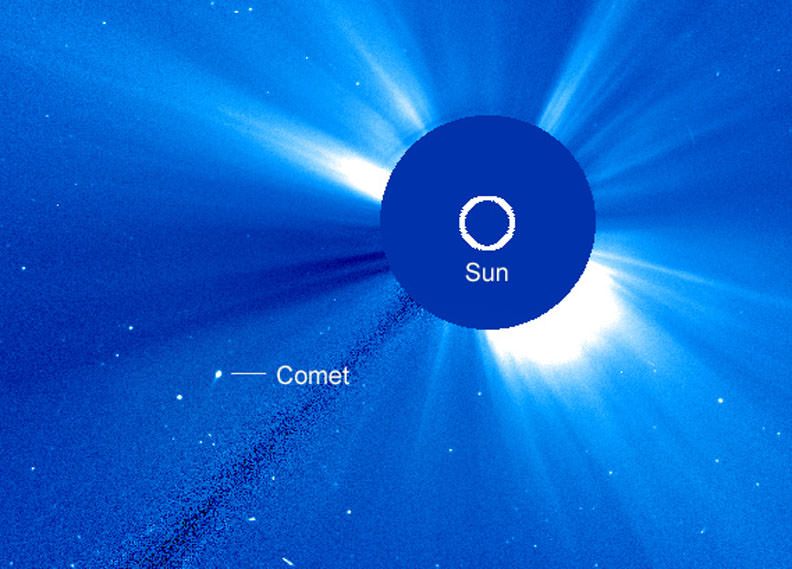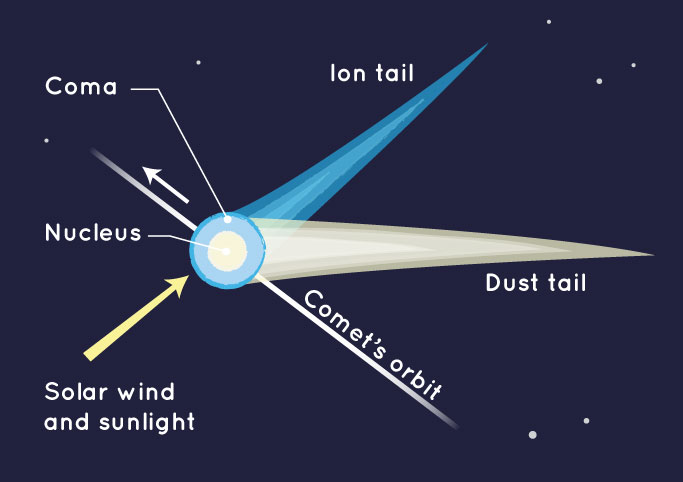Description

Copyright infringement not intended
Picture Courtesy: https://www.universetoday.com/119104/a-new-sungrazing-comet-may-brighten-in-the-evening-sky-heres-how-to-see-it/
Context: A sungrazer comet (SOHO-5008) was spotted near the sun during the total solar eclipse.
Details
- The recent discovery and observation of the comet SOHO-5008 during the total solar eclipse highlights a unique astronomical event where a sungrazing comet was briefly spotted before being destroyed by the intense heat and gravity of the sun.
Nature of Sungrazing Comets
- Sungrazing comets are a special category of comets that pass extremely close to the sun during their orbits, typically within a few million miles.
- Due to their proximity to the sun, sungrazers often disintegrate or vaporise due to intense solar heat and gravitational forces. This makes it challenging to study as they usually have short lifespans.
Significance of Sungrazing Comets
- Sungrazers provide valuable insights into the composition and behaviour of comets under extreme conditions near the sun.
- Most sungrazers are believed to be fragments of larger comets, such as those from the Kreutz group, which originated from a giant comet that broke apart centuries ago.
About Comets
- Comets are celestial bodies that orbit the Sun and consist predominantly of volatile ice.
- When comets approach the Sun, these ices sublimate (transition directly from solid to gas), along with entrained dust particles, creating a bright outflowing atmosphere around the comet nucleus known as a coma.

Key Characteristics of Comets
Composition and Sublimation
- Comets are primarily composed of volatile ices such as water ice, along with silicate and organic dust particles.
- When a comet approaches the Sun, the heat causes the ice to sublimate, releasing gases and dust that form a coma around the comet's nucleus.
Coma and Tails
- The coma is the freely escaping atmosphere of gas and dust that surrounds the comet's nucleus when it becomes active near the Sun.
- Comets develop two distinct types of tails:
- Dust Tail: Formed from dust particles carried away by solar radiation pressure, it appears as a long curving tail typically white or yellow in colour.
- Ion Tail: Composed of ionized molecules and radicals, it points directly away from the Sun due to the solar wind and glows bluish in colour.
Appearance and Display
- Comets are visually striking objects in the sky, displaying bright comae and tails that can extend over significant distances.
- They can appear unpredictably from any direction and remain visible for months as they move in eccentric orbits around the Sun.
Origin and Significance
- Comets are considered primitive bodies leftover from the early solar system, providing valuable insights into its formation and evolution.
- They formed in the outer regions of the solar nebula, beyond 5 astronomical units (AU) or beyond the orbit of Jupiter, where volatile ices could condense.
Nomenclature and Classification
- Comets are typically named after their discoverers, and some well-known comets bear the names of scientists who recognized their periodic orbits (e.g., Halley's Comet).
- The International Astronomical Union (IAU) assigns designations to comets based on their characteristics and orbits, distinguishing between long-period and periodic comets.
|
Halley's Comet
●Halley's Comet, officially designated as 1P/Halley, is a well-known short-period comet that orbits the Sun approximately every 75-79 years.
●It is the only comet of its kind that regularly appears visible to the naked eye from Earth. The comet was last visible in the inner parts of the Solar System during its 1986 visit and is expected to return next around mid-2061.
|
Conclusion
- Comets are ancient relics of the solar system's formation, exhibiting unique behaviours and appearances as they interact with the Sun's radiation and solar wind. Their study continues to enhance our understanding of planetary evolution and the conditions that prevailed during the early stages of the solar system's history.
Must Read Articles:
Total Solar Eclipse
Source:
The Times of India
Wikipedia
|
PRACTICE QUESTION
Q. Consider the following statements in the context of the Comets:
1. Comets develop a glowing coma and tail when they approach the Sun.
2. Halley's Comet is an example of a short-period comet.
3. The ion tail of a comet always points away from the Sun due to solar wind.
4. Comets originate from the Oort Cloud, a distant region of the solar system.
How many of the above statements are correct?
A) Only one
B) Only two
C) Only three
D) All four
Answer: D
|
















